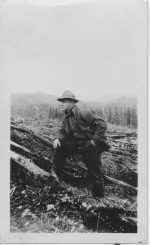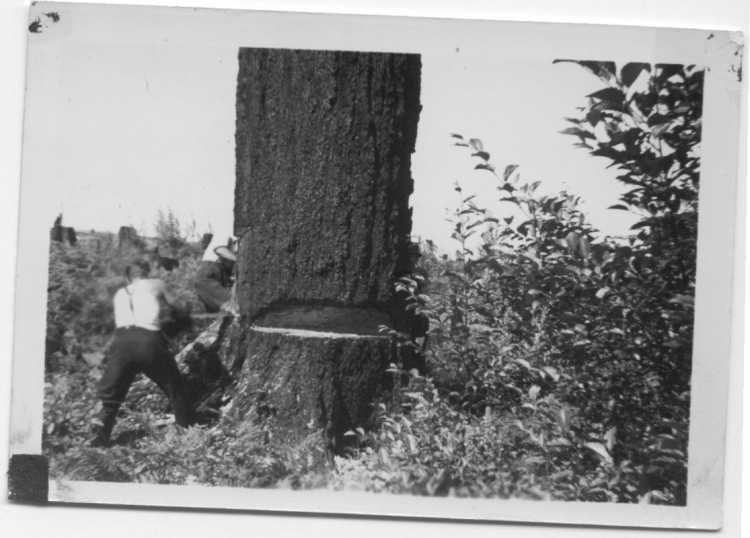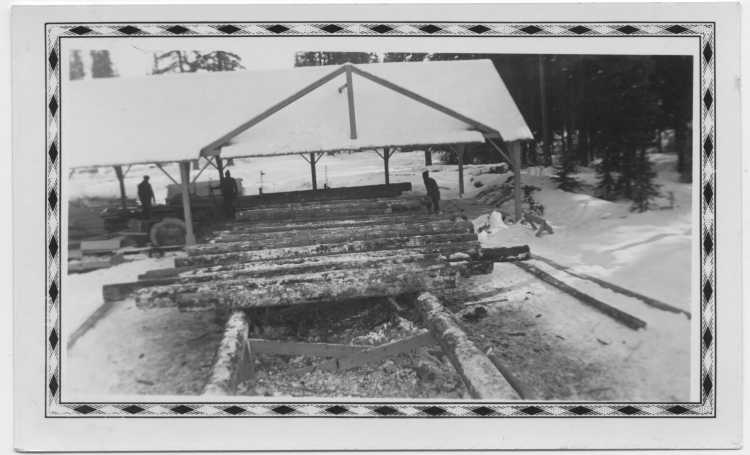Page
1 | Page 2 | Page
3 | Page 4 | Page
5 | Back to Work Page
Fires
are part of a forest's natural life cycle. Fire helps to clear away
the underbrush, making it easier for young trees to grow. Without
the seeds from mature trees, however, a new forest cannot grow.
This is what happened on Vancouver Island . Loggers in the 1930s
had taken away the oldest, most valuable trees. Then, in 1938, a
forest fire devastated the rest of the forest, leaving the landscape
blackened and scarred.

 |
| CO posing for a photo in a burned out area of the forest. |
Gordon
Dyck was one of the conscientious objectors who helped to give this
forest new birth. He explains how the forest died and how he helped
to revive it.
“The
1938 Campbell River fire had devastated a huge area and had ended
the ear of railroad logging here. With the advent of large trucks,
this method was being abandoned anyway. Railway beds had been
laid down through the forest and the logs were drawn by long cable
to the flat cars and loaded. Wherever one went, one would come
upon a railway bed, every half mile [800 m] or so. Another unique
feature, in absence of modern earth moving equipment and the presence
of seemingly unlimited timber, was that all ravines and even low
areas were bridged over. If an area called for a six-foot grade
[1.8 m], it was bridged over rather than filled in with earth.
One trestle was about 18 feet high [5.5 m] and half a mile long.
Those bridges crossing ravines were often very high. It was as
if the builders had said, “We can build a railway anywhere, just
don't ask us to move any dirt.”
 |
|
 |
Abe Thiessen
cutting down a large tree. |
Logs at sawmill |
Logs on the sawmill skidway |
“The
fire had destroyed the longer trestles, but the remaining ones
and the railways beds became our access routes to the camps and
our work areas. As the logging method had been extremely wasteful,
taking out only the best and convenient trees, the area was left
with a great number of trees killed by the fire, that needed to
be cut down to be able to control future fires. A dead and partly
rotten standing tree called a “snag,” was considered a great fire
hazard, as the fire would run up and the wind could then blow
burning embers a considerable distance. So during the winter we
cut them down and left them where they fell. Then in the cooler
seasons of spring and fall, we planted seedling trees in these
areas, right among the felled snag. Occasionally where loggers
had taken nothing, these dead trees now lay crisscross in a six
to eight foot [1.8 – 2.4 m] layer. We simply walked on top of
this mess and jumped down here and there to plant a tree. We wore
special logger's boots called caulk boots, with soles covered
with short spikes. Every store in town had a sign prohibiting
wearing them inside. The damage done to our bunk house floors
was considerable.” [ASP, 59-60]
 |
 |
 |
| Sawmill interior |
Sawmill interior |
Sawmill exterior |
Page
1 | Page 2 | Page
3 | Page 4 | Page
5 | Back to Work Page
|


